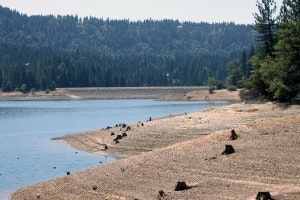How Drought Challenges Our Irrigation Systems

When you hear about water restrictions, do you immediately think about your yard turning brown? Ever wonder what our farmers must envision when they hear about water restrictions? It's worth thinking about since they are the ones who supply us with food. Mainly because if there's less water to grow food, there's bound to be less food to go around, and prices are going to go up.
Without water, everything dies. There are no crops and no meat.
That's why water is a precious resource, especially in drought-ridden California. Most agricultural businesses get their water from rivers, lakes, ponds, and streams. There are many ways to get it to their farms, but most of it arrives through irrigation. And now, the drought is having an impact on our irrigation systems.
Irrigation and Agriculture
One of the primary ways California farmers get water for their crops and livestock is through irrigation. When farmers use water applied as irrigation, it allows them to grow crops in arid regions. It also helps in areas that don't get enough rain, such as ours, supplementing soil moisture when it's humid.
Where Does the Local Water Come From?
NID water for irrigation is surface water originating as snowmelt found in 70,000 acres of high elevation watershed near the headwaters of the Yuba River, Bear River, and Deer Creek. The highest peak in the District is at an 8,373-foot elevation at English Mountain. Ground elevations within the District’s service area range from approximately 3,900 feet on Banner Mountain, above Nevada City at the eastern edge of the District, down to about 200 ft near the City of Lincoln.
The District transports raw water from high elevation mountain reservoirs to the lower elevation foothills and into portions of the northern Sacramento valley near the City of Lincoln.
NID raw water irrigates more than 30,000 acres of agricultural land used to grow multiple crops, including wine grapes, apples, rice, plums, citrus, grass, alfalfa hay, and irrigated pasture.
Of note, many growers also have groundwater wells, which are not part of NID’s delivery system.
How Water Gets to Irrigation Customers
The NID delivery system is supplied by diverting water into canals at either reservoirs or other diversion facilities located on streams. Typical canal operations divert enough flow to allow the purchased deliveries to each customer on the canal. To ensure proper flow rates through customer delivery points, the water surface in the canal is maintained at certain levels.
Most of the raw water use is during the irrigation season (April 15-October 14), based on a miner’s inch. The standard measurement for a miner’s inch requires a six-inch head of water over the center of the orifice and the water to free flow through the delivery point.
Watch a short video about a miner’s inch; click here.
For customers who purchase 40 miner’s inches or less, the amount of water is delivered through a standard water box and measured through an orifice sized for the amount of water purchased and the available head pressure.
What We’re Learning About the Drought and Irrigation Challenges
This past April, the Public Policy Institute of California released a report examining our agriculture sector, the largest in the country. Unfortunately, as far as irrigation goes, it's not good news. Farms in our state rely heavily on irrigation. While there has been work to improve irrigation efficiency, it's not enough.
And, of course, climate change is not helping matters.
Last year, the drought reduced surface water delivery to farms. This meant more farmers had to increase their groundwater pumping. But not all farmers have this as an option.
The report did suggest that state and federal agencies could provide technical and financial support to help farmers, such as "funding incentive programs." These programs would encourage strategic land fallowing and repurposing that could benefit the farms, local community, and environment.
Another big takeaway from the report is water storage improvement. It says that getting more water into the ground can recharge groundwater basins. To do this, the report suggests groundwater allocation and monitoring systems.
Other Drought Impacts on Agriculture
Drought is not only a famine situation. A lack of sufficient water can cause many other issues for agriculture, including insect outbreaks, insufficient soil nutrients, and wildfires. This affects the health of our farm and ranch communities and the number of jobs available.
The federal government regularly tracks drought issues across the country and updates its website. As of now:
- 1,650 counties that grow crops are experiencing drought
- That's 159 million acres of land in a drought
- 20.4 million beef cattle are living in a drought-stricken area
- 646 counties across the country have declared a drought
Much of this is happening right here in California.
Drought Status
California is facing historic levels of dryness that have gone on for three years. This year has endured the driest January, February, and March in more than 100 years. This prolonged drought has impacted regions throughout the state, and water districts have reacted to ensure water deliveries can continue.
On May 25, 2022, the NID Board of Directors adopted a resolution implementing Governor Gavin Newsom’s Executive Order. The order mandated California water agencies perform actions to achieve a 20 percent reduction in water use compared to 2020 levels.
Read about the resolution; click here.
Learning and Planning for the Future
Right now, NID is trying to plan for our communities' water needs in the next 50 years. Water for agricultural purposes is a massive part of that. As we look ahead, addressing the need for efficient irrigation will be extremely important in our planning. Not just for farmers and ranchers, but for all of us.
